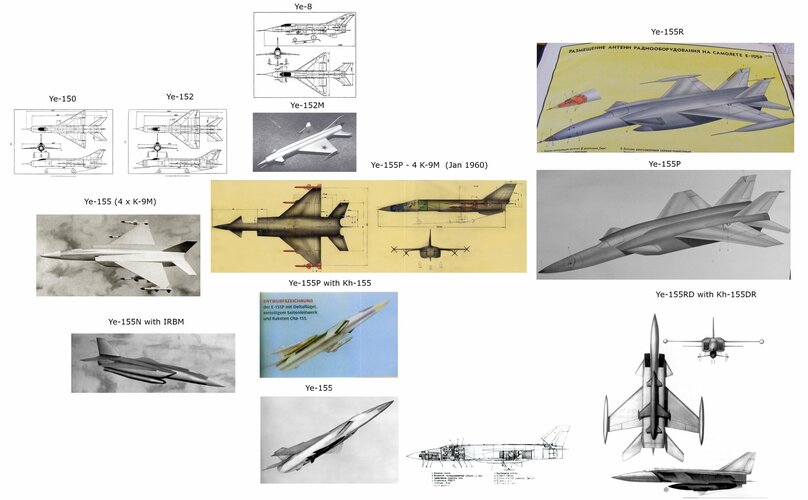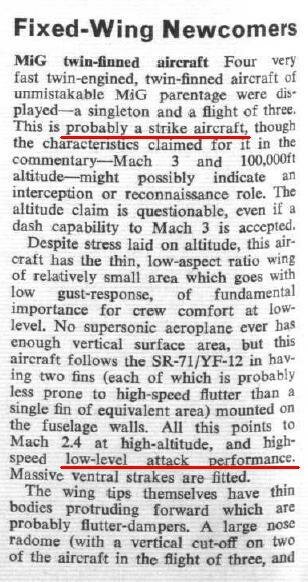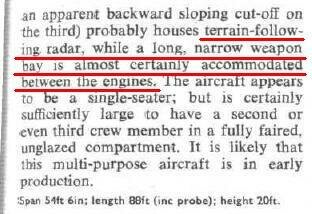You are using an out of date browser. It may not display this or other websites correctly.
You should upgrade or use an alternative browser.
You should upgrade or use an alternative browser.
North American WS-300 / A3J Vigilante heritage of MiG-25 layout
- Thread starter blackkite
- Start date
- Joined
- 27 December 2005
- Messages
- 17,758
- Reaction score
- 26,493
If you plot out the immediate predecessors to the MiG-25, and the early designs, it is clearly part of a smooth process of evolution. The diagram goes from left to right.

The earliest Ye-155 design (from 1958 - 1959) has a near identical wing to the Ye-152, being a cropped delta in order to carry wingtip missiles. The Ye-155 was in fact a reasonably simple enlargement of the Ye-152 configuration, with the engines moved outboard to accommodate more fuel in the fuselage also leaving the nose free for a large radar. Armament remained 4 x K-9M missiles as on the Ye-152. The canopy is barely visible, almost F-103 territory. Born in the missile era, it was initially intended to reach 4,000km/h and have mixed jet/rocket propulsion, but this was scaled back to a more achievable 3000km/h and purely jet propulsion. As well as interceptors, other roles were intended from the beginning, including a ballistic missile launcher.
The first design layout revision (by late 1959 - early 1960) added canards to improve supersonic stability. This was a short-lived fad seen on the Ye-8 and intended to be used on the Ye-152M and Ye-155 as well.
Then we have the next major change to the layout. The cropped delta wings are replaced by swept trapezoid wings, and the canards are moved rearwards. Twin vertical tails replace the single tail. It already looks like a MiG-25 now.
The first Ye-155 prototypes had the mount points for the canards fitted, but in flight testing they proved unnecessary. With the prototype-to-production

The earliest Ye-155 design (from 1958 - 1959) has a near identical wing to the Ye-152, being a cropped delta in order to carry wingtip missiles. The Ye-155 was in fact a reasonably simple enlargement of the Ye-152 configuration, with the engines moved outboard to accommodate more fuel in the fuselage also leaving the nose free for a large radar. Armament remained 4 x K-9M missiles as on the Ye-152. The canopy is barely visible, almost F-103 territory. Born in the missile era, it was initially intended to reach 4,000km/h and have mixed jet/rocket propulsion, but this was scaled back to a more achievable 3000km/h and purely jet propulsion. As well as interceptors, other roles were intended from the beginning, including a ballistic missile launcher.
The first design layout revision (by late 1959 - early 1960) added canards to improve supersonic stability. This was a short-lived fad seen on the Ye-8 and intended to be used on the Ye-152M and Ye-155 as well.
Then we have the next major change to the layout. The cropped delta wings are replaced by swept trapezoid wings, and the canards are moved rearwards. Twin vertical tails replace the single tail. It already looks like a MiG-25 now.
The first Ye-155 prototypes had the mount points for the canards fitted, but in flight testing they proved unnecessary. With the prototype-to-production
Last edited:
Similar threads
-
-
‘North American General Purpose Attack Weapon’ - NAGPAW to Vigilante
- Started by Pioneer
- Replies: 68
-
A
-
Various Mikoyan-Gurevich (MiG) Projects
- Started by hesham
- Replies: 164
-
MDP program - the Mikoyan Product 701
- Started by Tuomasn
- Replies: 30



